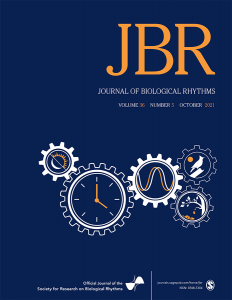Primarily offers papers describing original research into all aspects of biological rhythms
Latest topics of this journal:
SAGE Publications Inc: Journal of Biological Rhythms: Table of Contents
Circadian Rhythms in Health and Disease (CRHD 2024)
Journal of Biological Rhythms, Ahead of Print. <br/>
Author: Sandipan Ray, Srishti BanerjeeDepartment of Biotechnology, Indian Institute of Technology Hyderabad, Sangareddy, India
Posted: July 4, 2025, 10:04 am
How to Deal With Darkness: Modeling and Visualization of Zero-Inflated Personal Light Exposure Data on a Logarithmic Scale
Journal of Biological Rhythms, Ahead of Print. <br/>Measuring and analyzing personal light exposure has become increasingly important in circadian and myopia research. Very small measurement values in light exposure patterns, especially zero, are ...
Author: Johannes Zauner, Carolina Guidolin, Manuel Spitschan
Posted: June 28, 2025, 8:31 am
TRPV1 Desensitization Abolishes Metabolic Effects of Time-Restricted Feeding in Rats
Journal of Biological Rhythms, Ahead of Print. <br/>Time-restricted feeding (TRF) can improve metabolic outcomes. Rodents experiencing TRF exhibit an increase in spontaneous locomotor activity before mealtime and show a phase shift in the rhythm o...
Author: Nayara A.C. Horta, Thais S.R. Cardoso, Paola Fernandes, Flávia M. Araújo, Pedro Lucas Caillaux Luciano, Lucas R. Drummond, Cândido C. Coimbra, Maristela O. PoletiniDepartamento de Fisiologia e Biofísica, Instituto de Ciências Biológicas, Universidade Federal de Minas Gerais, Belo Horizonte, Brazil
Posted: June 28, 2025, 8:19 am
Chronic Phase Shifts Are Associated With Higher Systolic Blood Pressure and Impaired Glucose Tolerance Independently of Estrogen Deficiency in Female Spontaneously Hypertensive Rats
Journal of Biological Rhythms, Ahead of Print. <br/>Postmenopausal shift workers face increased cardiometabolic risk due to estrogen decline and shift work–induced circadian misalignment. Yet, their combined effects remain poorly understood, espec...
Author: Refentshe Amandu’s Nthlane, Karine Scheuermaier, Siluleko Advice Mkhize, Frédéric Sébastien Michel
Posted: June 20, 2025, 2:38 am
Clock-Dependent Phosphorylation of CikA Regulates Its Activity
Journal of Biological Rhythms, Ahead of Print. <br/>In the cyanobacterial circadian clock, a core oscillator comprising the proteins KaiA, KaiB, and KaiC keeps time based on a rhythmic phosphorylation of KaiC, and histidine protein kinases relay t...
Author: Cigdem Sancar, Susan S. Golden
Posted: June 19, 2025, 9:25 am
Sleep Identification Enabled by Supervised Training Algorithms (SIESTA): An Open-Source Platform for Automatic Sleep Staging of Rodent Electrocorticographic and Electromyographic Data
Journal of Biological Rhythms, Ahead of Print. <br/>Accurately capturing the temporal distribution of polysomnographic sleep stages is critical for the study of sleep function, regulation, and disorders in higher vertebrates. In laboratory rodents...
Author: Asad I. Beck, Carlos S. Caldart, Miriam Ben-Hamo, Tenley A. Weil, Jazmine G. Perez, Franck Kalume, Bingni W. Brunton, Horacio O. de la Iglesia, Raymond E. A. Sanchez
Posted: June 6, 2025, 10:18 am
Tracking Daily Variations in Rest-Wake to Guide Personalized Timing of Temozolomide for High-Grade Glioma Patients
Journal of Biological Rhythms, Ahead of Print. <br/>High-grade gliomas, like glioblastoma multiforme (GBM), are the most common malignant brain tumors in adults and are treated with the chemotherapy drug temozolomide (TMZ). In humans, a retrospect...
Author: Maria F. Gonzalez-Aponte, Anna R. Damato, Ruth G. N. Katumba, Grayson R. Talcott, Jian L. Campian, Omar H. Butt, Marc D. Ruben, Joshua B. Rubin, Erik D. Herzog, Olivia J. Walch
Posted: May 28, 2025, 6:17 am
Twenty-four-hour Skin Temperature Rhythms in Young People With Emerging Mood Disorders: Relationships With Illness Subtypes and Clinical Stage
Journal of Biological Rhythms, Volume 40, Issue 3, Page 262-274, June 2025. <br/>While circadian disruptions are common in some sub-groups of youth with mood disorders, skin temperature rhythms in these cohorts are understudied. We examined 24-h w...
Author: Mirim Shin, Joanne S. Carpenter, Shin H. Park, Connie Janiszewski, Emiliana Tonini, Sarah McKenna, Gabrielle Hindmarsh, Frank Iorfino, Alissa Nichles, Natalia Zmicerevska, Elizabeth M. Scott, Benjamin L. Smarr, Ian B. Hickie, Jacob J. Crouse
Posted: April 26, 2025, 8:34 am

